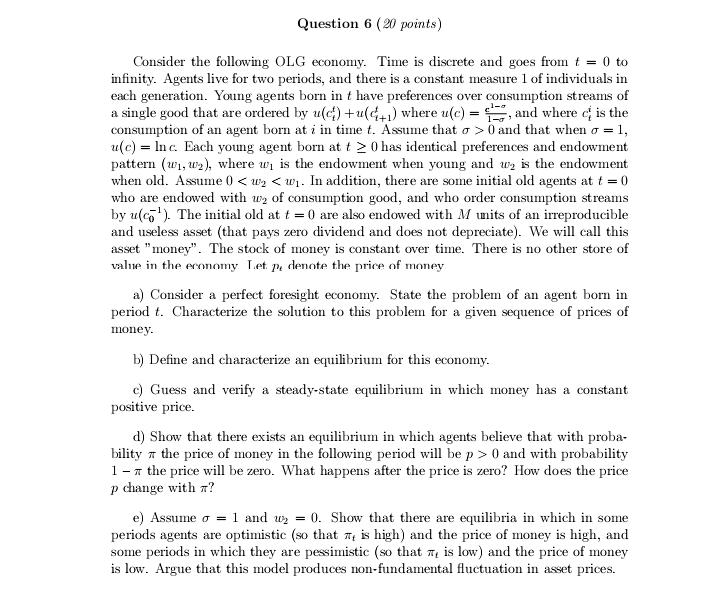
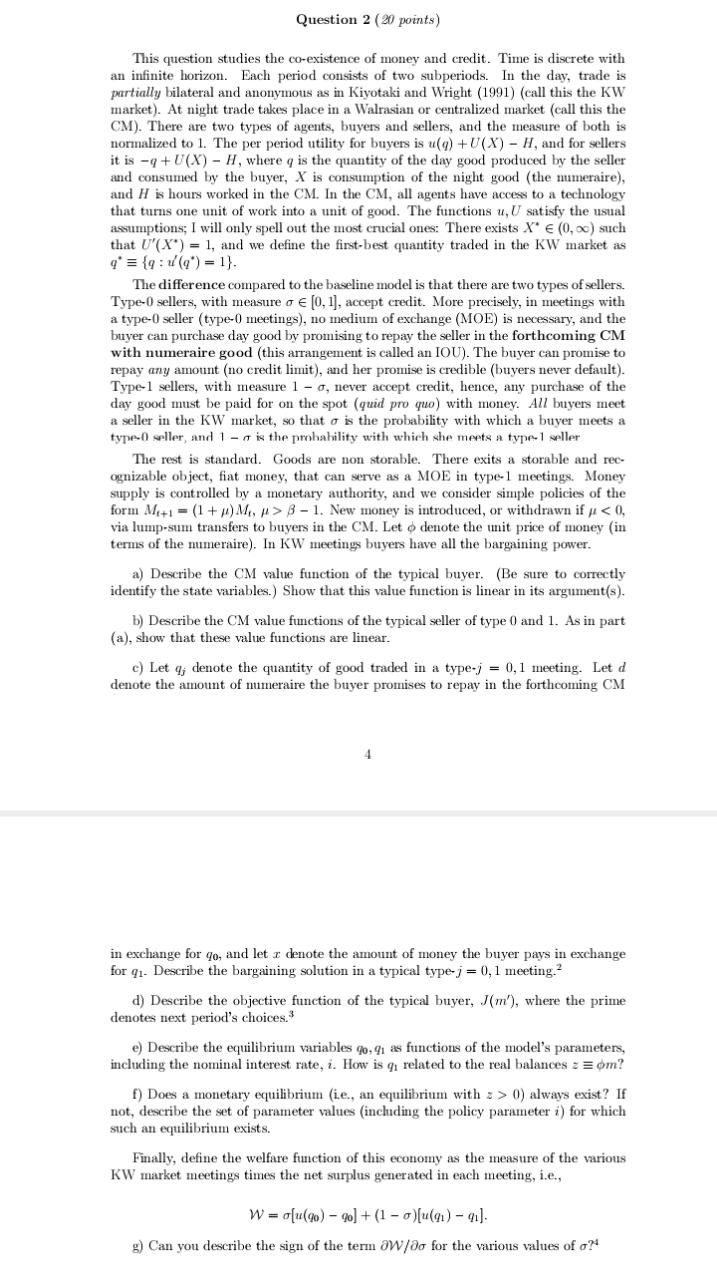
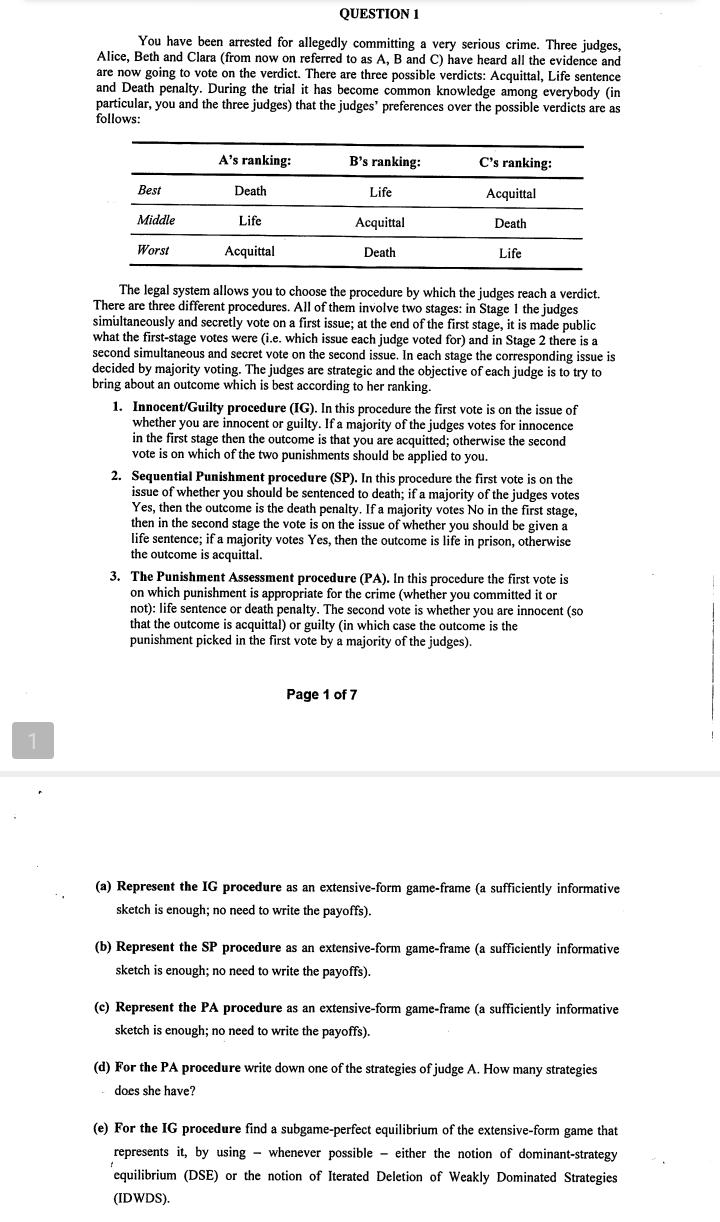
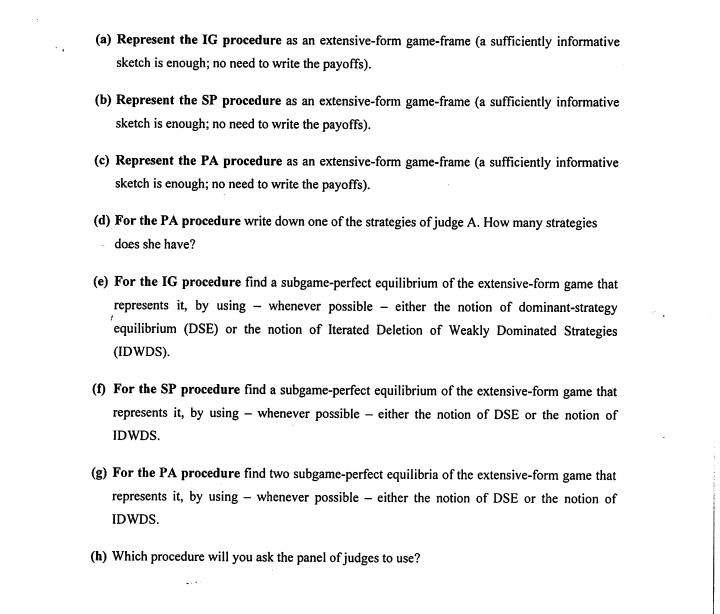
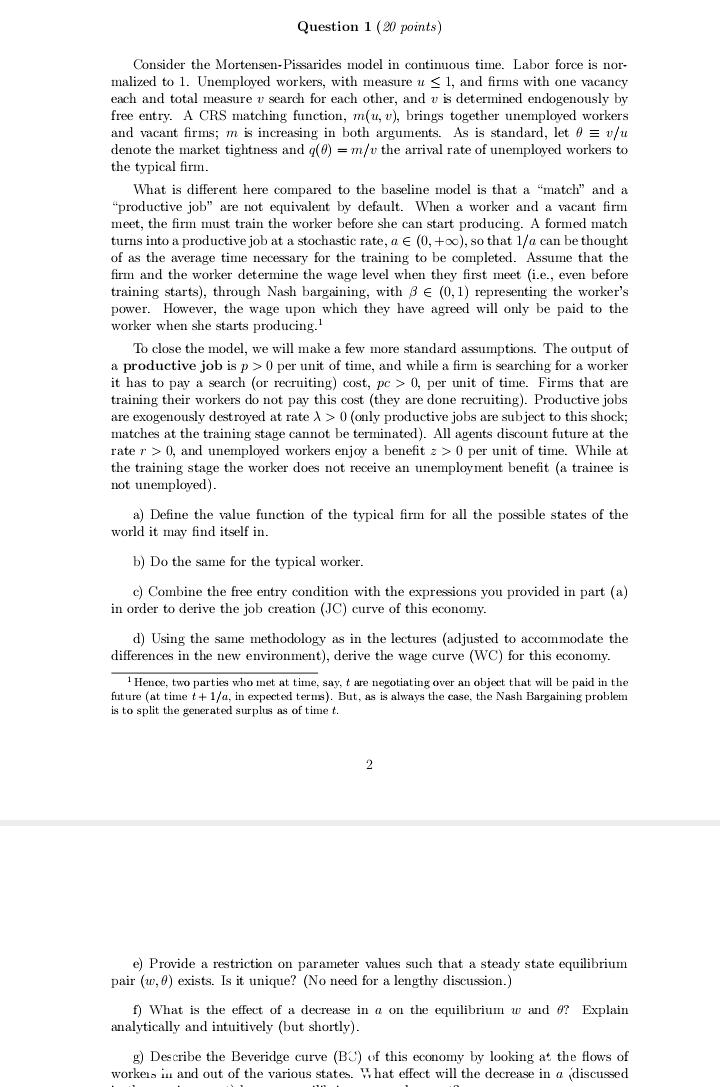
Show all the workings..
Question 6 (20 points) Consider the following OLG economy. Time is discrete and goes from { = 0 to infinity. Agents live for two periods, and there is a constant measure 1 of individuals in each generation. Young agents born in t have preferences over consumption streams of a single good that are ordered by a(c ) tu(cq ) where u(c) = $, and where of is the consumption of an agent born at i in time f. Assume that o > 0 and that when o = 1, u(c) = Inc. Each young agent born at t 2 0 has identical preferences and endowment pattern (w1, w2), where wj is the endowment when young and wy is the endowment when old. Assume 0 0 and with probability 1 - * the price will be zero. What happens after the price is zero? How does the price p change with a? e) Assume o = 1 and us = 0. Show that there are equilibria in which in some periods agents are optimistic (so that #, is high) and the price of money is high, and some periods in which they are pessimistic (so that m, is low) and the price of money is low. Argue that this model produces non-fundamental fluctuation in asset prices.Question 2 (20 points) This question studies the co-existence of money and credit. Time is discrete with an infinite horizon. Each period consists of two subperiods. In the day, trade is partially bilateral and anonymous as in Kiyotaki and Wright (1991) (call this the KW market). At night trade takes place in a Walrasian or centralized market (call this the CM). There are two types of agents, buyers and sellers, and the measure of both is normalized to 1. The per period utility for buyers is u(q) + U(X) - H, and for sellers it is -q + U(X) - H, where q is the quantity of the day good produced by the seller and consumed by the buyer, X is consumption of the night good (the numeraire), and H is hours worked in the CM. In the CM, all agents have access to a technology that turns one unit of work into a unit of good. The functions u, U satisfy the usual assumptions; I will only spell out the most crucial ones: There exists X" E (0, co) such that U'(X*) = 1, and we define the first-best quantity traded in the KW market as q' = (q : (q') = 1}. The difference compared to the baseline model is that there are two types of sellers. Type-0 sellers, with measure o E [0, 1), accept credit. More precisely, in meetings with a type-0 seller (type-0 meetings), no medium of exchange (MOE) is necessary, and the buyer can purchase day good by promising to repay the seller in the forthcoming CM with numeraire good (this arrangement is called an IOU). The buyer can promise to repay any amount (no credit limit), and her promise is credible (buyers never default). Type-1 sellers, with measure 1 - o, never accept credit, hence, any purchase of the day good must be paid for on the spot (quid pro quo) with money. All buyers meet a seller in the KW market, so that o is the probability with which a buyer meets a type-0 seller, and 1 - a is the probability with which she meets a type-1 seller The rest is standard. Goods are non storable. There exits a storable and rec- ognizable object, fiat money, that can serve as a MOE in type-1 meetings. Money supply is controlled by a monetary authority, and we consider simple policies of the form Mi+1 = (1+ p)M, p> 8 - 1. New money is introduced, or withdrawn if a > 0) always exist? If not, describe the set of parameter values (including the policy parameter ?) for which such an equilibrium exists. Finally, define the welfare function of this economy as the measure of the various KW market meetings times the net surplus generated in each meeting, i.e., W = olu(go) - 90] + (1 - o)[u(q) - qi]. g) Can you describe the sign of the term OW/do for the various values of o?*QUESTION 1 You have been arrested for allegedly committing a very serious crime. Three judges, Alice, Beth and Clara (from now on referred to as A, B and C) have heard all the evidence and are now going to vote on the verdict. There are three possible verdicts: Acquittal, Life sentence and Death penalty. During the trial it has become common knowledge among everybody (in particular, you and the three judges) that the judges' preferences over the possible verdicts are as follows: A's ranking: B's ranking: C's ranking: Best Death Life Acquittal Middle Life Acquittal Death Worst Acquittal Death Life The legal system allows you to choose the procedure by which the judges reach a verdict. There are three different procedures. All of them involve two stages: in Stage I the judges simultaneously and secretly vote on a first issue; at the end of the first stage, it is made public what the first-stage votes were (i.e. which issue each judge voted for) and in Stage 2 there is a second simultaneous and secret vote on the second issue. In each stage the corresponding issue is decided by majority voting. The judges are strategic and the objective of each judge is to try to bring about an outcome which is best according to her ranking. 1. Innocent/Guilty procedure (IG). In this procedure the first vote is on the issue of whether you are innocent or guilty. If a majority of the judges votes for innocence in the first stage then the outcome is that you are acquitted; otherwise the second vote is on which of the two punishments should be applied to you. 2. Sequential Punishment procedure (SP). In this procedure the first vote is on the issue of whether you should be sentenced to death; if a majority of the judges votes Yes, then the outcome is the death penalty. If a majority votes No in the first stage, then in the second stage the vote is on the issue of whether you should be given a life sentence; if a majority votes Yes, then the outcome is life in prison, otherwise the outcome is acquittal. 3. The Punishment Assessment procedure (PA). In this procedure the first vote is on which punishment is appropriate for the crime (whether you committed it or not): life sentence or death penalty. The second vote is whether you are innocent (so that the outcome is acquittal) or guilty (in which case the outcome is the punishment picked in the first vote by a majority of the judges). Page 1 of 7 (a) Represent the IG procedure as an extensive-form game-frame (a sufficiently informative sketch is enough; no need to write the payoffs). (b) Represent the SP procedure as an extensive-form game-frame (a sufficiently informative sketch is enough; no need to write the payoffs). (c) Represent the PA procedure as an extensive-form game-frame (a sufficiently informative sketch is enough; no need to write the payoffs). (d) For the PA procedure write down one of the strategies of judge A. How many strategies does she have? (e) For the IG procedure find a subgame-perfect equilibrium of the extensive-form game that represents it, by using - whenever possible - either the notion of dominant-strategy equilibrium (DSE) or the notion of Iterated Deletion of Weakly Dominated Strategies (IDWDS).(a) Represent the IG procedure as an extensive-form game-frame (a sufficiently informative sketch is enough; no need to write the payoffs). (b) Represent the SP procedure as an extensive-form game-frame (a sufficiently informative sketch is enough; no need to write the payoffs). (c) Represent the PA procedure as an extensive-form game-frame (a sufficiently informative sketch is enough; no need to write the payoffs). (d) For the PA procedure write down one of the strategies of judge A. How many strategies does she have? (e) For the IG procedure find a subgame-perfect equilibrium of the extensive-form game that represents it, by using - whenever possible - either the notion of dominant-strategy equilibrium (DSE) or the notion of Iterated Deletion of Weakly Dominated Strategies (IDWDS). (f) For the SP procedure find a subgame-perfect equilibrium of the extensive-form game that represents it, by using - whenever possible - either the notion of DSE or the notion of IDWDS. (g) For the PA procedure find two subgame-perfect equilibria of the extensive-form game that represents it, by using - whenever possible - either the notion of DSE or the notion of IDWDS. (h) Which procedure will you ask the panel of judges to use?Question 1 (20 points) Consider the Mortensen-Pissarides model in continuous time. Labor force is nor- malized to 1. Unemployed workers, with measure u 2 1, and firms with one vacancy each and total measure v search for each other, and v is determined endogenously by free entry. A CRS matching function, m(u, v), brings together unemployed workers and vacant firms; m is increasing in both arguments. As is standard, let 0 = v/u denote the market tightness and q(0) = m/v the arrival rate of unemployed workers to the typical firm. What is different here compared to the baseline model is that a "match" and a "productive job" are not equivalent by default. When a worker and a vacant firm meet, the firm must train the worker before she can start producing. A formed match turns into a productive job at a stochastic rate, a E (0, +co), so that 1/a can be thought of as the average time necessary for the training to be completed. Assume that the firm and the worker determine the wage level when they first meet (i.e., even before training starts), through Nash bargaining, with 3 6 (0, 1) representing the worker's power. However, the wage upon which they have agreed will only be paid to the worker when she starts producing.' To close the model, we will make a few more standard assumptions. The output of a productive job is p > 0 per unit of time, and while a firm is searching for a worker it has to pay a search (or recruiting) cost, pc > 0, per unit of time. Firms that are training their workers do not pay this cost (they are done recruiting). Productive jobs are exogenously destroyed at rate A > 0 (only productive jobs are subject to this shock; matches at the training stage cannot be terminated). All agents discount future at the rate r > 0, and unemployed workers enjoy a benefit > > 0 per unit of time. While at the training stage the worker does not receive an unemployment benefit (a trainee is not unemployed). a) Define the value function of the typical firm for all the possible states of the world it may find itself in. b) Do the same for the typical worker. c) Combine the free entry condition with the expressions you provided in part (a) in order to derive the job creation (JC) curve of this economy. d) Using the same methodology as in the lectures (adjusted to accommodate the differences in the new environment), derive the wage curve (WC) for this economy. 1 Hence, two parties who met at time, say, t are negotiating over an object that will be paid in the future (at time t + 1/a, in expected terms). But, as is always the case, the Nash Bargaining problem is to split the generated surplus as of time t. 2 e) Provide a restriction on parameter values such that a steady state equilibrium pair (w, 0) exists. Is it unique? (No need for a lengthy discussion.) f) What is the effect of a decrease in a on the equilibrium w and o? Explain analytically and intuitively (but shortly). g) Describe the Beveridge curve (BU) of this economy by looking at the flows of workers in and out of the various states. What effect will the decrease in a discussed
















